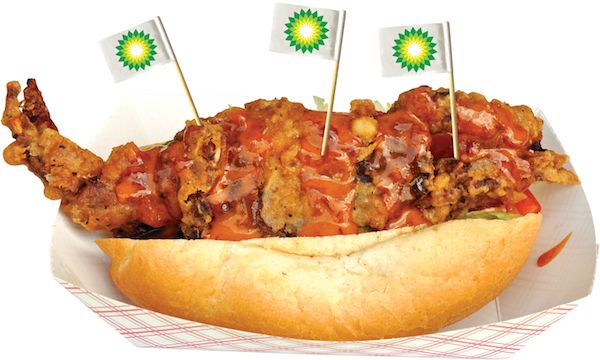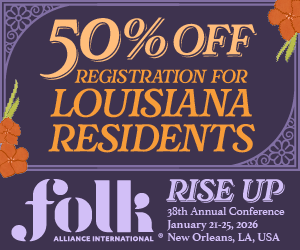During a memorable set at last year’s Jazz Fest, Eddie Vedder of Pearl Jam took to the bully pulpit and skewered BP for the disaster that was becoming the Deepwater Horizon. In not-so-kind words, he strongly encouraged BP’s executives to send down their sons and daughters to clean up the oil spill.
At that time, the great tide of fear had begun setting in not just in southeast Louisiana, but around the globe. Fear not just about what was happening to the ecosystem attached to the Gulf of Mexico, but fear of a selfish kind. Would we be able to eat ice cold, raw oysters? Would the piping hot fried shrimp po-boy become a legend of the past like Lafitte’s treasure? Would trout meuniere, sputtering with butter, still be the non-meat punishment for Catholics on Fridays in Lent?
Into this backdrop, one may be expected to find the seafood vendors at this year’s New Orleans Jazz and Heritage Fest pissed off and fed up at what the oil spill has done to their business and livelihood. Instead, Mike Gowland, a vendor at Jazz Fest, is upbeat and confident. “Save for the price going up a small bit, I haven’t had any trouble sourcing my shrimp,” Gowland said in early April.
Gowland serves alligator sauce piquante, shrimp and grits, and shrimp and okra gumbo from his perch in Food Area I. The alligator is all sourced from alligator farms that would not have been affected at all by the BP Oil Spill boondoggle. His shrimp are still plump, Louisiana U-40-50s (meaning 40 to 50 shrimp per pound). Gowland buys them peeled to save time, but other than that, they are as natural as they day they were caught.
Gowland credits the Louisiana Seafood Marketing Board with doing a tremendous job in getting out the message that Louisiana’s seafood is safe. Ewell Smith of Louisiana Seafood Promotion and Marketing Board has spearheaded a campaign not only to deal with the crisis on the Gulf Coast which he says is just now ending, but also to get the word out to all areas of the country that Louisiana seafood is safe and ready to eat. “We have transitioned from the crisis stage to a marathon,” Smith says.
Armed with dedicated funds and a national PR firm, the debate can now be framed on the reality—Louisiana seafood is safe— rather than the perception. “Our production levels are back across the board save oysters,” Smith says. “Only reason oyster production is down is because of the fresh water diversion projects. But oyster production should be back to pre- spill levels in two to three years.”
Oysters are the filtration system of the Gulf Coast. “And they are just as good as before,” says Jeff Levi. Now in his 26th year at the Fest, Levi began selling oyster Rockefeller as a way to get oysters into Jazz Fest. Originally, there were concerns of pieces of oyster shell getting lodged on the track, which could harm the ponies.
Levi will go through anywhere from 150 to 200 gallons of bisque this year, a process which begins about a week before the event. Levi will slowly simmer lobster stock, herbs, aromatics, spices, Louisiana Herbsaint, heavy cream, and a peanut butter-colored roux for 4-5 hours. This mixture is then quickly chilled and transported to the Fair Grounds, where it will be reheated. Just prior to service, Levi will sauté meaty Louisiana Select oysters until they puff up, then layer them on top of the soup with a grating of Parmesan cheese to mimic the classic dish made famous by Antoine’s.
Levi also mentioned that the only noticeable difference in the oysters post-BP Spill is that pricing has gone up. “Sometimes that is just the cost of doing business,” Levi says in a taciturn manner.
When we spoke by phone, Levi had just returned from his oyster purveyor to check on the quality of the oysters he would serve at Jazz Fest. While he doesn’t preclude the BP Spill as the major reason for the price increase, he quickly points out that seafood prices always “jump every 4-5 years for some reason or another.”
The great fear referenced above seems to rank up there with the Boogie Man and showing up to school in your underwear. For now, it is time to focus on reality. A reality filled with plump, salty oysters, sweet shrimp, fatty crabs, and fresh fish from the Gulf and her estuaries.





